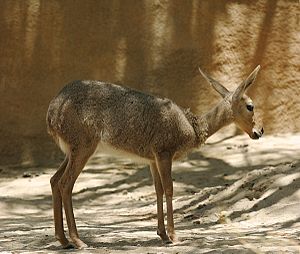Deer antelope
| Deer antelope | ||||||||||||
|---|---|---|---|---|---|---|---|---|---|---|---|---|

Deer antelope |
||||||||||||
| Systematics | ||||||||||||
|
||||||||||||
| Scientific name of the genus | ||||||||||||
| Pelea | ||||||||||||
| JE Gray , 1851 | ||||||||||||
| Scientific name of the species | ||||||||||||
| Pelea capreolus | ||||||||||||
| ( Forster , 1790) |
The Gray Rhebok ( Pelea capreolus ) is only in South Africa and Lesotho and in Swaziland widespread Hornträger . In English-speaking countries, this small antelope is named with its Afrikaans name Rhebok , as it reminded the first immigrants of the familiar deer . The name "Rehböckchen" is also common in German.
features
With a weight of 20 kg and a shoulder height of 75 cm, the roebuck is a small and graceful antelope. The coat is gray, thick and woolly on the top and white on the underside. The running style is "rocking horse-like". The deer antelope has long, narrow ears and a large, black nose that looks puffy. Only males have slender, straight horns.
distribution
The original distribution area included the Republic of South Africa and Lesotho, Swaziland and southern Botswana . Today the animals generally stay in mountainous or hilly areas. They can be found in the nature reserves Bontebok and Giant's Castle , as well as in the Malolotja National Park in Swaziland. The natural habitat also includes grass savannahs from which they only disappeared due to hunting pressure.
Way of life
Deer antelopes eat leaves and grass and also enjoy themselves in grain fields. They are diurnal and move over the rocks as good jumpers. When running fast, they hold their tails upright so that their bright white underside is revealed to a pursuer.
The deer antelope lives in packs, with one male and several females and their offspring. The male defends the group of ten on average against intruders. In doing so, they often become very aggressive and can dangerously injure or even kill their peers with their sharp horns. Attacks on sheep and goats are also attested. One group member always keeps watch while the others eat.
Taxonomy
Only a few horn-bearers have a more changeable past than the deer antelope with regard to the systematic position. George Gaylord Simpson initially saw them as a small relative of the water buck and reed buck , in the further course of the 20th century they were assigned to the gazelle or goat type , sometimes also to the originally broader goats , or formed their own tribe or subfamily (Peleini or Peleinae ). Only in the transition to the 21st century did new morphological and genetic studies reveal evidence of a very close relationship with the water buck and reed buck, as was initially thought. Don E. Wilson and DeeAnn Reeder's Mammal Species of the World (2005) finally classifies them into the Reduncinae, later the subfamily was shifted to the rank of a tribe ( Reduncini ).
literature
- Colin P. Groves , David M. Leslie Jr .: Family Bovidae (Hollow-horned Ruminants). In: Don E. Wilson, Russell A. Mittermeier (eds.): Handbook of the Mammals of the World. Volume 2: Hooved Mammals. Lynx Edicions, Barcelona 2011, ISBN 978-84-96553-77-4 , p. 682.
- DE Wilson, DM Reeder: Mammal Species of the World . Johns Hopkins University Press, Baltimore 2005, ISBN 0-8018-8221-4 .
Individual evidence
- ↑ https://apiv3.iucnredlist.org/api/v3/taxonredirect/16484
- ^ George Gaylord Simpson: The Principles of Classification and a Classification of Mammals. Bulletin of the American Museum of Natural History 85, 1945, pp. 1–350 (p. 159)
- ↑ Alexandre Hassanin, Emmanuel JP Douzery: The Tribal Radiation of the Family Bovidae (Artiodactyla) and the Evolution of the Mitochondrial Cytochrome b Gene. Molecular Phylogenetics and Evolution 13 (2), 1999, pp. 227-243
- ↑ Peter Grubb: Genus Pelea Gray Rhebok. In: Jonathan Kingdon, David Happold, Michael Hoffmann, Thomas Butynski, Meredith Happold, Jan Kalina (eds.): Mammals of Africa Volume VI. Pigs, Hippopotamuses, Chevrotain, Giraffes, Deer and Bovids. Bloomsbury, London, 2013, pp. 120–606 (p. 416)
- ↑ Colin P. Groves , David M. Leslie Jr .: Family Bovidae (Hollow-horned Ruminants). In: Don E. Wilson, Russell A. Mittermeier (eds.): Handbook of the Mammals of the World. Volume 2: Hooved Mammals. Lynx Edicions, Barcelona 2011, ISBN 978-84-96553-77-4 , p. 682
Web links
- Pelea capreolus in the endangered Red List species the IUCN 2006. Posted by: Castley et al , 2003. Retrieved on 12 May, 2006.